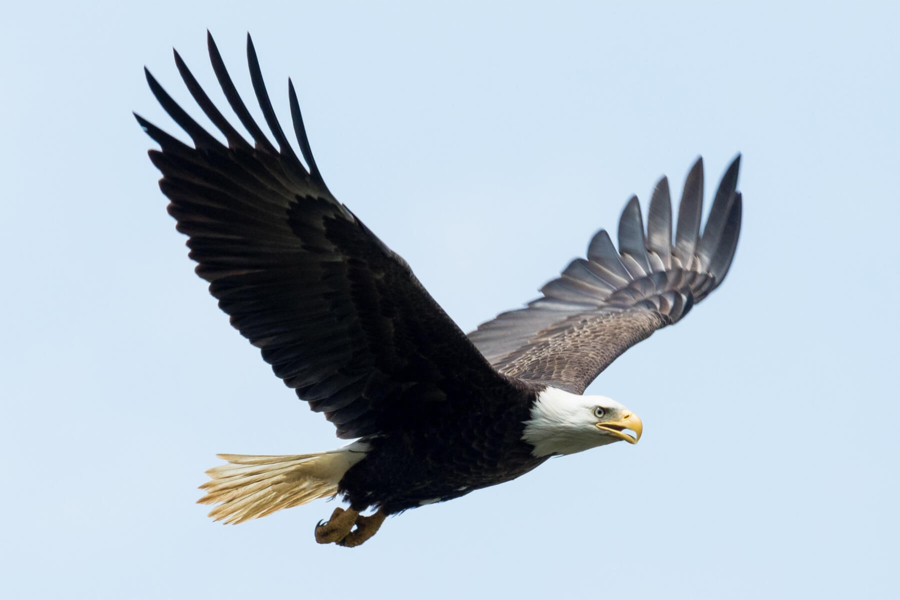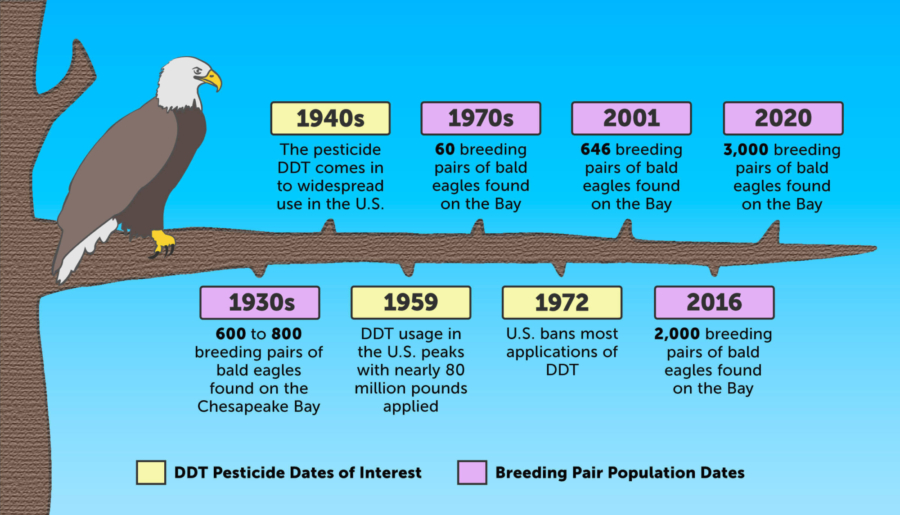Bald Eagles
After widespread pesticide use devastated the region's bald eagle population, a ban on DDT and the active management of eagle habitat helped the region become home to one of the nation's highest concentrations of these iconic birds.

Overview
The population of bald eagles in the Chesapeake Bay has significantly increased in the past decade due to a ban on the chemical DDT as well as wildlife management from across the region. In the 1970’s, there were as few as 60 breeding pairs of the iconic bird in the entire Bay region, but numbers have soared back. Continued management of this species is needed to ensure its safety.
How many bald eagles are in the Bay?
In 2020, 3,000 breeding pairs of bald eagles were estimated to be in the Chesapeake Bay, up 1,000 pairs from 2016. The 2020 estimation was based on various data including the James River aerial survey. Maryland stopped surveying bald eagles in 2004 when documented nearly 400 breeding pairs statewide, surpassing population goals. Virginia ended its annual survey in 2016 after counting almost 1,100 breeding pairs.

Show image description
The infographic shows a bald eagle sitting on a branch, which is used to represent a timeline of the Chesapeake Bay watershed's bald eagle population from the 1930s to 2020. In the 1930s, there were 600 to 800 breeding pairs of bald eagles found on the Chesapeake Bay. In the 1940s, the pesticide DDT came into widespread use in the United States. In 1959, DDT usage in the United States peaked with nearly 80 million pounds applied. In the 1970s, 60 breeding pairs of bald eagles were found on the Bay. In 1972, the United States banned most applications of DDT. In 2001, 646 breeding pairs of bald eagles were found on the Bay. In 2016, 2,000 breeding pairs of bald eagles were found on the Bay. And in 2020, 3,000 breeding pairs of bald eagles were found on the Bay.
What impacts bald eagles?
In the Chesapeake Bay watershed, bald eagles are currently most impacted by habitat loss. When forests along the shoreline are cut down or disrupted by development, bald eagles have a more difficult time breeding and building nests. The amount of fish available in the water, which is impacted by the quality of the water, also affects bald eagles. Additionally, human-made contaminants such as lead poisoning can impact bald eagles. In a 2022 study in the Journal of Wildlife Management, researchers found that eating fragments of lead bullets used for hunting reduced Bald Eagle population growth by 4 to 6% in the northeastern United States due to lead bullets used for hunting.
What kind of bald eagles live in the Bay?
The Chesapeake Bay supports three populations of bald eagles: those that live in the region year-round, those that come here from the Southeast to spend the summer months and those that come here from the Northeast to spend the winter months. The convergence of three geographically distinct populations in the region suggests the Bay plays a particularly important role in bald eagle recovery.
Why do bald eagles visit the Bay?
Forested areas along the Bay and its river offer bald eagles quiet, undisturbed areas to make their nests and hunt for fish. Bald eagles also enjoy the low depth of the Bay and its rivers because it means they can more easily spot fish in the water. As an estuary, the Bay is a mix of freshwater and saltwater, which means it has a variety of fish species. Bald eagles enjoy this diverse menu of food and will often nest in between areas of fresh and saltwater. Additionally, wildlife refuges in the area offer habitat for bald eagles.
Where can you find bald eagles in the Bay?
Sections of the eastern and western shores of the Bay, plus the James, Potomac and Rappahannock rivers are currently hotspots for bald eagles because of their forested shorelines. Major wildlife refuges also support bald eagle populations. Some of the bigger wildlife refuges in the watershed include Mason Neck National Wildlife Refuge along the Potomac River, Rappahannock National Wildlife Refuge and Aberdeen Proving Ground, both on the western side of the Bay, and Blackwater National Wildlife Refuge on the eastern side in Dorchester County, Maryland—the county with the largest breeding populations in the region. The Conowingo Dam is also a great place to observe bald eagles. The birds visit the dam because of the fish that build up at the dam. However, this is not an example of sustainable habitat for bald eagles.
The recovery of bald eagles in the Chesapeake Bay
It’s believed that the Chesapeake Bay once supported the densest population of bald eagles in the country. However, a combination of habitat loss and the chemical contaminants. In the mid-1940s, the pesticide DDT was developed and used to control insects in farm fields, homes and gardens. The toxic chemical entered the food chain and caused a deep bald eagle population decline: by the early 1960s, the region supported 150 breeding pairs and reproductive rates reached an all-time low. By the early 1970s, about 60 pairs remained.
Fortunately, the elimination of toxic pesticides and the active management of eagle habitat have allowed eagles to recover. Following the DDT ban, bald eagles were listed under the Endangered Species Act, which allocated resources to protecting the species, and the Chesapeake Bay became an area dedicated to eagle recovery. Within the region, conservation practices such as limits on how close to a nest development can occur, as well as restrictions against construction during nesting and mating seasons, helped bald eagles successfully breed. In the 1960’s, the National Wildlife Refuge System began purchasing areas for the protection of bald eagles.
In 1988, the bald eagle was downlisted from being an endangered species and delisted in 1999. Today, the population is the highest it's been in nearly 100 years.
How can you help?
To protect bald eagles, consider using non-toxic pesticides or chemical-free cleaning products to curb the amount of toxic contaminants entering the water. You can also follow safe and legal disposal methods for paint, motor oil and other household chemicals, and keep pharmaceuticals out of waterways by returning unused medicine to a consumer drug return location.
